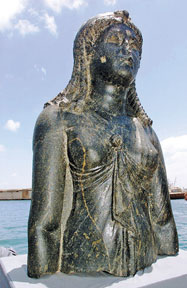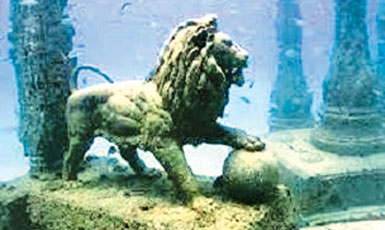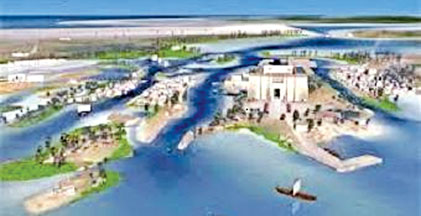
City submerged for 1,200 years reveals its secrets
You may think of this as a fairy tale or a fantasy or a myth. It
would have been a myth or a fairy tale if not for French underwater
archaeologist Dr Franck Goddio who was surveying the Mediterranean Sea
for French warships that sank there in the 18th century battle of the
Nile.
  Dr. Goddio was taken by surprise when he discovered a port city
submerged under the Mediterranean Sea. It was a strange sight as well as
a strange world. Dr. Goddio was taken by surprise when he discovered a port city
submerged under the Mediterranean Sea. It was a strange sight as well as
a strange world.
This strange discovery is of Thonis-Heracleion a city lost between
legend and reality. Before the foundation of Alexandria in 331 BC, the
city knew glorious times as the obligatory port of entry to Egypt for
all ships coming from the Greek world.
The city was founded probably around the 8th century BC, underwent
diverse catastrophes and finally sunk entirely in the sea in the 8th
century AD.
It has been there for some 1,200 years before Dr Goddio's sudden
discovery. Along with his team from the European Institute for
Underwater Archaeology, Dr Goddio unearthed the lost city revealing a
treasure trove of artifacts and ruins some 30ft under the sea in Aloukir
Bay, Alexandria. For the past 13 years they have been excavating the
area, lifting up pieces of history, long since forgotten, from the
bottom of the ocean.
To this day few can tell with absolute certainty why this city itself
was plunged into the murky depths of the Mediterranean Sea. What caused
it to sink? Did it collapse? Was a natural disaster to blame?
Dr Goddio's team have spent countless hours piecing together evidence
trying to find answers for those questions. As more fragments and
elements are brought to the surface his team has been able to create a
virtual model of what the city might have looked in those times.
Dr.Goddio has found important information on the ancient landmarks of
Thonis-Heracleion such as the grand temple of Amun and his son Khonson
(Herakles for the Greeks). The harbours that once controlled all trade
into Egypt and daily life of the people.
  He has also solved a historic question that has puzzled Egyptologists
over the years: the archaeological material has revealed that Heracleion
and Thonis were one and the same city with two names. Heracleion being
the name given by the Greeks and Thonis by the Egyptians. He has also solved a historic question that has puzzled Egyptologists
over the years: the archaeological material has revealed that Heracleion
and Thonis were one and the same city with two names. Heracleion being
the name given by the Greeks and Thonis by the Egyptians.
According to the popular view Thonis-Heracleion was in fact a port
due to its location - acting as an entry point for merchants and trade.
The items that have been found also support the theory, gold coins,
stone ledgers and even weights all suggests a city bustling with energy,
commerce and transactions. They have also discovered the remains of more
than 64 ships buried in the thick clay and sand that now covers the sea
bed.
Dr Danian Robinson, director of the Oxford centre for Maritime
Archaeology at the University of Oxford, who is part of the team working
on the site says that the site had amazing preservation and adds that
had been a major international port for Egypt at that time and also it
was where taxes and duties were levied on important export items.
Among the discoveries are colossal statues of the Egyptian goddess
Isis, the god Hapi, and an unidentified Egyptian pharaoh all preserved
in immaculate condition by their muddy burial ground. Along with these
16 foot statues there are hundreds of smaller statues of Egyptian gods -
among them the figures that guarded the temple where Cleopatra was
inaugurated as Queen of the Nile.
In Amun - Gereb, the most important temple of the supreme god of the
Egyptians, dozens of sarcophagi have been found, containing the bodies
of mummified animals sacrificed to the God. Many amulets or religious
charms have been unearthed, too, showing gods such as Isis, Osiris and
Horus.
 The Greek historian Herodotes (5th century) tells us of a great
temple that was built where the famous hero Herakles first set foot on
Egypt. The Greek historian Herodotes (5th century) tells us of a great
temple that was built where the famous hero Herakles first set foot on
Egypt.
He also reports of Helen's visit to Heracleion with her lover Paris
before the Trojan War. More than four centuries after Herodotusí visit
to Egypt, geographer Strabo observed that the city of Heracleion which
possessed the temple of Herakles is located straight to the east of
canopus at the mouth of the canopic branch of the River Nile.
Going by the numerous archaeological finds Heracleion flourished
especially from the 6th to the 4th century BC. And according to the
popular views the city sank in the 6th or 7th century AD, probably due
to major earthquakes and floods. Until Dr Franck Goddio unearthed this
glorious city scholars were not sure if Heracleion and Thonis were in
fact one and the same city. |

